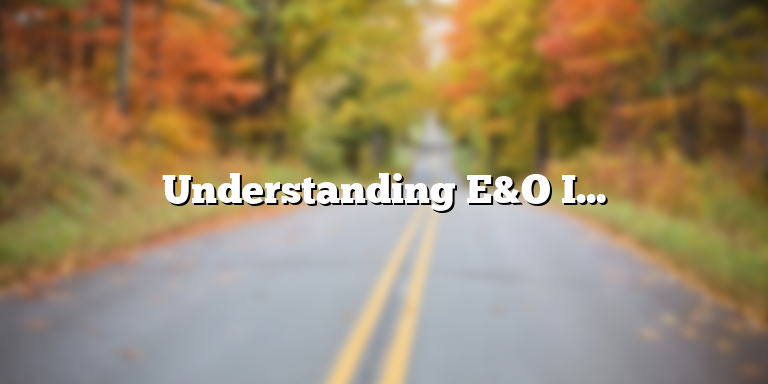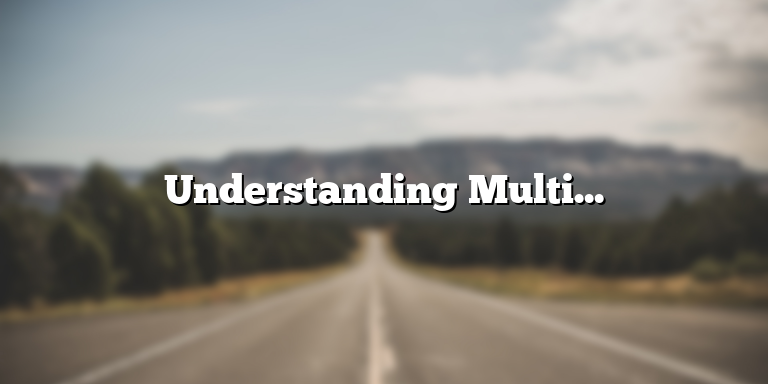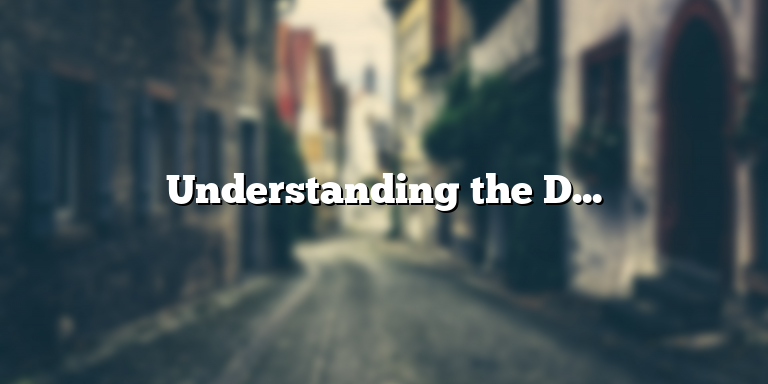
What is E&O Insurance?
Errors and omissions insurance, also known as E&O insurance, is a type of professional liability insurance that protects businesses and individuals from claims of inadequate work, errors, and negligence. It provides coverage for claims resulting from a breach of professional duty or alleged failure to perform services.
E&O insurance is not a “one-size-fits-all” policy, and it can vary depending on your industry and the services you offer. It’s important to understand the risks associated with your profession and make sure your policy covers the specific areas of potential liability.
Who Needs E&O Insurance?
While E&O insurance is typically associated with certain professions such as lawyers, doctors, and financial advisors, any business that provides a service or advice should consider E&O insurance. If a client feels they have suffered financial loss as a result of your work, they may decide to take legal action against you. E&O insurance covers the cost of legal defense and any resulting damages or settlements.
Here are some examples of businesses that should consider E&O insurance:
- Real estate agents and brokers
- Accountants and tax preparers
- Marketing and advertising agencies
- Technology consultants
- IT professionals
- Event planners
- Insurance agents and brokers
If your business provides a service or advice, then you should consider E&O insurance. Accidents and mistakes happen, so it’s better to be protected.
What does E&O Insurance Cover?
E&O insurance policies typically cover legal defense costs, settlements, and damages related to claims of alleged negligence or errors. Some policies may also include coverage for infringement of intellectual property, breach of contract, and defamation claims.
For example, if you’re a marketing agency and you provide erroneous information to a client, they may try to sue you for financial losses. If you have E&O insurance, it would cover the cost of legal defense and any ensuing damages or settlements.
It’s important to note that E&O insurance will not cover intentional acts, criminal activity, or claims of bodily injury or property damage. Businesses need a separate policy for those types of claims.
Conclusion
Errors and omissions insurance is an important policy for any business that provides a service or advice. It provides protection against claims of negligence, errors, and inadequate work. If you’re unsure if your business needs E&O insurance, consult with an insurance professional who can help assess your exposure to risk and recommend the appropriate coverage.
Who Needs E&O Insurance?
Errors and Omissions (E&O) insurance or professional liability insurance is an essential type of insurance policy that provides protection to businesses and professionals from lawsuits. These lawsuits can result from errors, mistakes, neglect, or malpractice that they committed while catering to their clients or customers.
While many businesses or individuals might think that their general liability insurance or commercial insurance policies will cover them against such claims, it’s not always the case. That’s where E&O insurance comes in handy. It can help protect your business’s reputation, financial resources, and future growth by covering legal fees, settlements, judgements, and other expenses resulting from a covered claim.
Professionals Who Need E&O Insurance
Professional liability insurance can be beneficial for a wide range of individuals, including the following:
- Doctors and Medical Professionals: Medical professionals, including dentists, chiropractors, and other clinicians, are required to carry E&O insurance in most states. This is because a single mistake in their profession can result in significant harm to the patient or their family. Medical malpractice insurance can protect medical professionals from lawsuits involving allegations of negligence, error, or misconduct.
- Real Estate Agents: Real estate brokers and agents can face negligence claims when they don’t provide the expected level of service to their clients, such as failing to disclose property defects or potential zoning issues. E&O insurance can help cover these claims.
- Lawyers: Lawyers and law firms can be held accountable for mistakes that they commit, such as missing a deadline, providing incorrect advice, or breaching client confidentiality. Legal malpractice insurance can help protect them from the financial damages arising from such lawsuits.
- Financial Advisors: Financial advisors can face lawsuits from clients who claim that their investment recommendations were incorrect or failed to meet their expectations. E&O insurance can help financial advisors cover legal costs, judgments, and settlements resulting from such claims.
- Technology Professionals: Technology professionals, including software developers, IT consultants, and website designers, can face lawsuits related to system failures, data breaches, and intellectual property disputes. Errors and omissions insurance can help protect these professionals from costly legal damages.
Industries That Need E&O Insurance
Aside from individuals, certain industries may require E&O insurance as a regulatory and contractual requirement, including:
- Insurance Companies: Insurance companies are required to provide E&O insurance to their agents and brokers under state regulations. This insurance protects agents against lawsuits resulting from errors or omissions in their work.
- Construction Industry: Contractors, architects, engineers, and other professionals in the construction industry may face lawsuits arising from design errors, project delays, or construction defects. E&O insurance can help protect the construction industry from such claims.
- Advertising and Marketing: Advertising agencies, graphic designers, and other creative professionals can be sued for false advertising, copyright infringement, or other similar claims. E&O insurance can help cover these claims.
- Human Resources and Employment: Companies that specialize in human resources services and employment placement can be sued for negligence, discrimination, wrongful termination, and other claims related to employment. E&O insurance can help provide protection from such lawsuits.
Regardless of your profession or industry, investing in E&O insurance can help safeguard your business and its assets. It’s important to discuss your specific risks and needs with an experienced insurance agent to find the best coverage for your business or individual practice.
What Does E&O Insurance Cover?
If you run a business, you have likely heard of the term E&O insurance, which stands for errors and omissions insurance. This type of insurance is essential for any business that provides professional services, such as legal or accounting services, engineering consultancy, or even healthcare services.
When you offer professional services, you are liable for any mistakes or oversights you make in your work. These errors or omissions can inflict financial damage to your clients and put your business at risk.
This is where errors and omissions insurance comes in, as it can help protect your business from the financial strain that may arise from such mistakes. In this article, we will go over what E&O insurance covers to help you understand what you need to shield your business operation.
Professional Errors and Omissions
Errors and omissions insurance provides coverage when errors or omissions are made in your professional services. This may include instances where advice given to your clients leads to negative consequences, like financial loss, or if there is a breach of contract. Professional errors and omissions can be broadly classified into two categories – negligent and non-negligent mistakes.
Negligent mistakes occur when you fail to take reasonable care or do not follow standard industry practices or regulations. For example, if your accountant fails to file taxes or misrepresents financial reports to your clients, he or she can be held liable for the financial loss caused by that mistake.
Non-negligent mistakes can include any error or omission that arises from circumstances beyond your control. For instance, an architect designing a building may use the latest technology and materials, but a natural disaster like an earthquake can still cause unforeseen damage to the property, resulting in loss for their clients.
Privacy Breach Coverage
In today’s digital age, privacy breach coverage is an essential component of errors and omissions insurance. This coverage is intended to protect your business and your clients in the event of a data breach. If your professional advice leads to a security breach where clients’ personal data is compromised, E&O insurance may cover the necessary legal or forensic procedures, and it may also provide other support services to mitigate reputational damage and rebuild trust with your clientele base.
This coverage has become even more important now that businesses collect sensitive customer data through digital platforms like cloud storage and social media accounts. No business is completely immune to data breaches, so it is essential to have the right coverage to safeguard your clients’ data and your company’s reputation.
Defense Costs
In the case of professional liability claims, errors and omissions insurance may cover an array of defense costs ranging from legal fees to expenses incurred during the investigation process. Both negligent and non-negligent mistakes can lead to expensive and time-consuming lawsuits that impact your business’s bottom line. With E&O insurance covering defense costs, you can be assured that your business will not have to shoulder the legal expenses that might arise from litigation.
However, it is essential to note that the defense costs coverage limit may differ from the policy limit, so it is always wise to consider the cost implications of different errors and omissions insurance policies before you purchase one.
Conclusion
Understanding what E&O insurance covers is crucial to determine whether your business requires such protection. Liability due to errors and omissions is a significant risk for businesses that offer professional services. Having errors and omissions insurance can provide support and, in some cases, act as a client retention tool, crucial to help you protect your business from financial loss and reputational damage.
It is essential to work with a professional broker who understands the nuances of your profession and the different E&O coverage options available. That way, you can select the most suitable policy for your business and needs.
What is Not Covered Under E&O Insurance?
Errors and omissions (E&O) insurance is a type of policy that protects professionals from lawsuits that arise due to errors or omissions made during the course of their work. Commonly known as professional liability insurance, E&O coverage is designed to cover a wide range of professions, including lawyers, accountants, real estate agents, engineers, architects, and healthcare professionals. However, there are certain exclusions that are not covered under E&O insurance policies. In this article, we will explore what is not covered under E&O insurance and why it is important to understand these limits.
Types of Damages Not Covered by E&O Insurance
While E&O insurance is designed to provide protection for professionals against claims of negligence, there are certain types of damages that may not be covered under this policy. Some examples of these include:
Bodily Injury and Property Damage
E&O policies typically exclude coverage for damages caused by bodily injury or property damage. If a client or third party claims that they suffered physical harm or property damage as a result of a professional’s error or omission, this type of damage will not be covered by E&O insurance. Instead, the professional may need to look for coverage under a general liability policy or a separate policy that covers property damage or bodily injury.
Criminal Acts
Most E&O policies will not cover criminal acts committed by a professional. If a professional is found to have engaged in fraud, embezzlement, or other criminal activities, their E&O policy will not provide protection against lawsuits arising from these actions. In fact, some insurers may even exclude any claim arising from an intentional act or omission.
Punitive Damages
Many E&O policies do not cover punitive damages, which are awarded to a plaintiff with the intention of punishing the defendant for their actions. Punitive damages are typically awarded in cases where the defendant’s conduct was particularly egregious or reckless.
Claims Made After Policy Expiration
E&O policies are claims made insurance policies, which means that they only provide coverage for claims that are made during the policy period. If a claim is made after the policy has expired, the professional will not be covered by their E&O insurance policy, even if the error or omission occurred while the policy was in effect. Professionals can protect themselves from this issue by purchasing a tail policy that extends coverage for a specified period after the policy has expired.
Why Understanding E&O Insurance Limits is Important
Understanding the limits of E&O insurance is crucial for professionals in a variety of industries. Without an understanding of what is and is not covered under their policy, professionals may find themselves facing unexpected costs and legal fees in the event of a lawsuit. By knowing the scope of their coverage, professionals can make informed decisions about how much coverage they need and whether they should purchase additional policies to protect themselves against potential liability.
In conclusion, E&O insurance is a valuable protection for any professional who wants to minimize the risks associated with errors or omissions. However, it is important to understand the limits of this coverage, including types of damages that may not be covered. By doing so, professionals can ensure that they have the right protection in place to safeguard their business and reputation.
How Much Does E&O Insurance Cost?
Errors and omissions insurance, commonly known as E&O insurance, is a type of professional liability coverage that helps protect businesses from financial loss due to lawsuits arising from their professional services. Like any insurance policy, the cost of E&O coverage can vary depending on a variety of factors. Understanding these factors can help business owners determine the cost of E&O insurance and make the best decision for their specific needs.
Industry
One of the biggest factors that influence the cost of E&O insurance is the industry that a business operates in. Some industries, such as engineering and accounting, have a higher risk of lawsuits due to potential errors or mistakes in their work. Businesses in these industries typically pay higher premiums for E&O insurance coverage due to the higher risk. On the other hand, industries such as retail or hospitality may have lower risks for professional liability lawsuits, resulting in lower premiums.
Coverage Limits
Another key factor that can affect the cost of E&O insurance is the amount of coverage that a business needs. Coverage limits refer to the maximum amount that an insurance policy will pay out in the event of a claim. Businesses that require higher coverage limits will typically pay more for their E&O insurance premiums than those with lower limits. This is because the insurance company is taking on more risk by providing a higher payout in the event of a lawsuit. Business owners should consider their specific needs and risk factors when determining what coverage limits are necessary.
Claims History
The history of claims and lawsuits against a business can also influence the cost of E&O insurance. A business with a history of claims or lawsuits will typically be considered a higher risk by insurance companies, resulting in higher premiums. On the other hand, businesses with a clean claims record may qualify for lower premiums. It’s important for business owners to carefully manage their claims history and work to minimize their risk of lawsuits and claims.
Other Factors
Other factors that can impact the cost of E&O insurance include the size of the business, the scope of services provided, and the deductible amount. Larger businesses with more employees may pay higher premiums than smaller businesses due to the increased risk of lawsuits. The scope of services provided by a business can also impact the cost – those providing more specialized or complex services may require higher coverage limits and thus, higher premiums. Deductible amounts can also influence premiums – higher deductibles typically result in lower premiums, while lower deductibles result in higher premiums.
Overall, the cost of E&O insurance can vary greatly depending on a variety of factors. Business owners should carefully consider their specific needs and risk factors when determining how much coverage to purchase and at what cost.
How to Choose an E&O Insurance Provider
Errors and omissions (E&O) insurance protects individuals and businesses from claims of negligence or inadequate work. While the policy you choose will depend on your profession and needs, there are several factors to consider when choosing an E&O insurance provider.
Experience and Expertise
When choosing an E&O insurance provider, consider how long they have been providing coverage and their expertise in your industry. You want to work with a provider who understands the potential risks and liabilities of your line of work. They should have experience in providing custom policies to fit your unique needs.
Reputation
Research the provider’s reputation before making a decision. Look for reviews from current or previous policyholders online. Check with industry associations or licensing boards to see if the provider has any complaints or disciplinary actions. You may also want to ask for references directly from the provider.
Financial Stability
E&O insurance claims can be expensive, so it’s important to choose a provider that has the financial stability to pay out claims if necessary. Check the provider’s ratings with credit rating agencies such as Moody’s or A.M. Best. Review their financial statements or annual reports to ensure they have the financial backing to provide coverage for the long-term.
Policy Terms and Conditions
Review the policy terms and conditions before signing up with an E&O insurance provider. Make sure you understand the coverage limits, deductibles, and any exclusions. Ask for clarification if there is anything you don’t understand. You want to know what you are paying for, what is covered and what is not, and how the policy will respond to different scenarios.
Cost
Cheaper doesn’t always mean better when it comes to E&O insurance. While the cost is an important factor, it shouldn’t be the only factor. You want to balance the cost with coverage, experience, and reputation. Consider getting quotes from a few different providers to compare costs and policies. Remember that investing in quality coverage now can save you significant costs down the road.
Customer Service and Claims Support
Consider the provider’s customer service and claims support. You want to work with a provider that has a responsive claims process and can help you in case of an alleged negligence claim. Do they provide 24/7 claims support? Do they offer online tools to manage your policy or file a claim? Will you have a dedicated claims representative? These are all important questions to ask.
Choosing an E&O insurance provider that fits your needs and profession is not a decision to be made lightly. Take your time, consider important factors, and ask questions to ensure you’re choosing the right provider for your insurance needs.
How to Make a Claim on E&O Insurance
Errors and omissions (E&O) insurance, also known as professional liability insurance, provides coverage for businesses and individuals in the event of a claim brought against them for an error or omission that caused harm to a third party. If you have E&O insurance, it is important to understand the claims process and what is required of you if you need to file a claim.
Step 1: Notify Your Insurance Company
If you believe you have an E&O claim, the first step is to notify your insurance company as soon as possible. Make sure to provide them with all necessary details, including the name of the claimant, the nature of the claim, and any relevant documentation. Failure to notify your insurance company in a timely manner could result in your claim being denied.
Step 2: Provide Documentation
Your insurance company will require documentation to support your claim. This may include contracts, emails, invoices, and other relevant correspondence. Make sure to provide your insurance company with any documentation they request in a timely manner, as delays could prolong the claim process.
Step 3: Investigation
Once your insurance company receives your claim and all necessary documentation, they will begin an investigation. This may include contacting the claimant, reviewing contracts and other documents, and consulting with experts in the relevant field. The purpose of the investigation is to determine whether your E&O insurance policy covers the claim and if so, to what extent.
Step 4: Negotiation and Settlement
If your insurance company determines that your E&O policy covers the claim, they will begin negotiations with the claimant to reach a settlement. The settlement may involve payment to the claimant, or your insurance company may provide legal defense in the event of a lawsuit. If a settlement cannot be reached, your insurance company may proceed with a trial.
Step 5: Resolution
If a settlement is reached, your insurance company will issue payment to the claimant. If a lawsuit proceeds, your insurance company will provide legal defense. If you are found liable in court, your E&O policy will cover the damages awarded to the claimant, up to the policy limit.
Understanding the claims process for E&O insurance is essential for any business or individual who carries this type of policy. Make sure to notify your insurance company as soon as possible if you believe you have an E&O claim, provide all necessary documentation, and cooperate with your insurance company throughout the investigation and settlement process.





